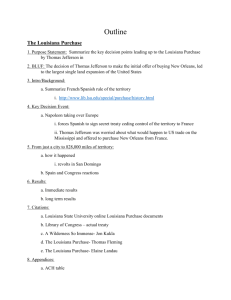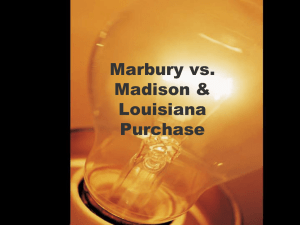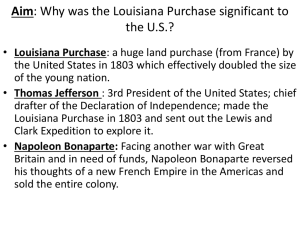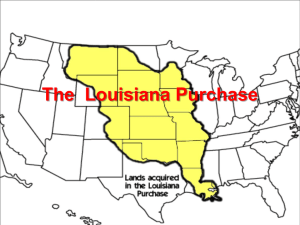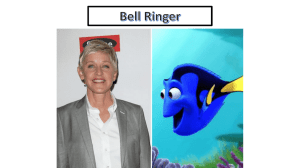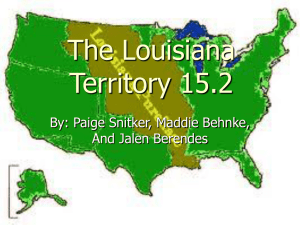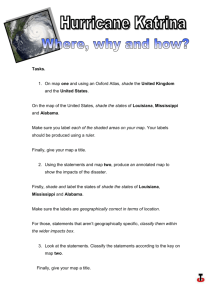Louisiana
advertisement
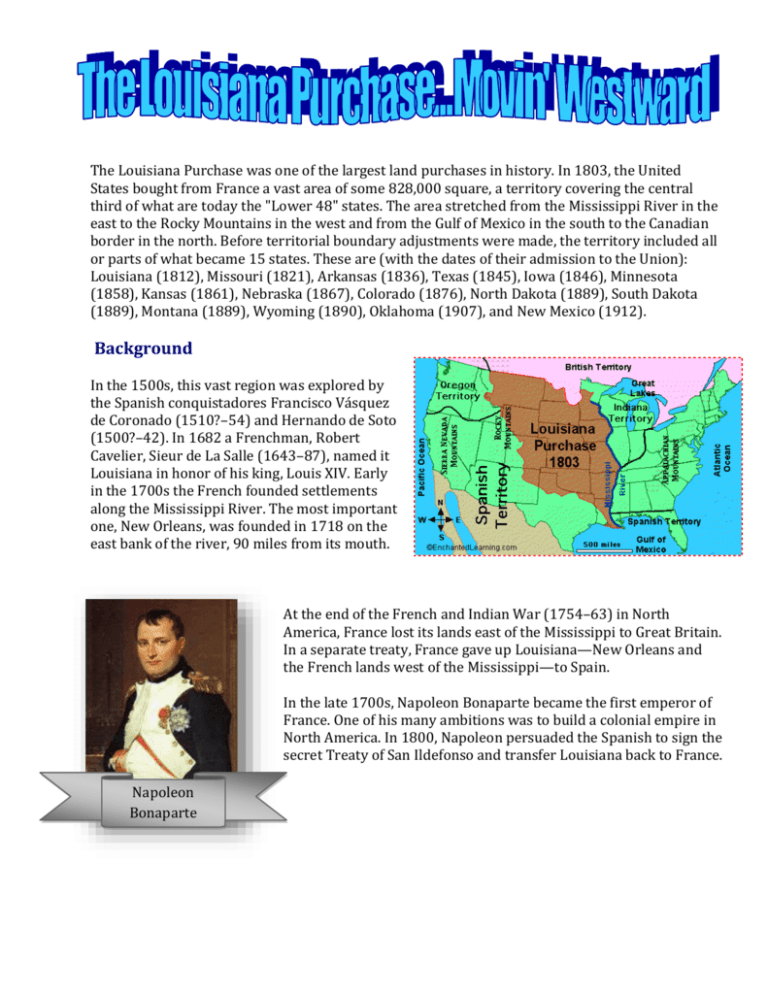
The Louisiana Purchase was one of the largest land purchases in history. In 1803, the United States bought from France a vast area of some 828,000 square, a territory covering the central third of what are today the "Lower 48" states. The area stretched from the Mississippi River in the east to the Rocky Mountains in the west and from the Gulf of Mexico in the south to the Canadian border in the north. Before territorial boundary adjustments were made, the territory included all or parts of what became 15 states. These are (with the dates of their admission to the Union): Louisiana (1812), Missouri (1821), Arkansas (1836), Texas (1845), Iowa (1846), Minnesota (1858), Kansas (1861), Nebraska (1867), Colorado (1876), North Dakota (1889), South Dakota (1889), Montana (1889), Wyoming (1890), Oklahoma (1907), and New Mexico (1912). Background In the 1500s, this vast region was explored by the Spanish conquistadores Francisco Vásquez de Coronado (1510?–54) and Hernando de Soto (1500?–42). In 1682 a Frenchman, Robert Cavelier, Sieur de La Salle (1643–87), named it Louisiana in honor of his king, Louis XIV. Early in the 1700s the French founded settlements along the Mississippi River. The most important one, New Orleans, was founded in 1718 on the east bank of the river, 90 miles from its mouth. At the end of the French and Indian War (1754–63) in North America, France lost its lands east of the Mississippi to Great Britain. In a separate treaty, France gave up Louisiana—New Orleans and the French lands west of the Mississippi—to Spain. In the late 1700s, Napoleon Bonaparte became the first emperor of France. One of his many ambitions was to build a colonial empire in North America. In 1800, Napoleon persuaded the Spanish to sign the secret Treaty of San Ildefonso and transfer Louisiana back to France. Napoleon Bonaparte Crisis over Louisiana When President Thomas Jefferson learned of the secret agreement, he was very worried. He did not welcome the idea of gaining a strong France neighbor in the west (in place of a weak Spanish neighbor). Jefferson was additionally fearful that if the French went on to control New Orleans, they would close the Mississippi River to American trade. This happened sooner than he expected. On October 15, 1802, the king of Spain finally gave the order transferring Louisiana to France. But the Spanish governor in New Orleans was unaware of the mandate. The following day he suddenly withdrew the right of deposit, the right that allowed American shippers to leave their goods at New Orleans while awaiting transfer onto oceangoing vessels. Seeing their means of making a living threatened, western fur trappers and traders demanded that the United States seize Louisiana by force. As it turned out, this was not necessary. Jefferson ordered Robert R. Livingston the American foreign minister to France, to explore the possibility of purchasing New Orleans and West Florida. Jefferson used psychology to force Napoleon's hand. He permitted certain letters to fall into the hands of French agents that hinted at a joint U.S.-British attack on Louisiana. One of the letters to Livingston said, "The day that France takes possession of New Orleans… we must marry ourselves to the British fleet and nation." In March 1803, James Monroe left for Paris as a special envoy. Congress had given him the power to offer Napoleon up to $10 million for New Orleans and a tract of land on the Gulf of Mexico. Robert R. Livingston By the time Monroe arrived in Paris on April 12, Napoleon had already decided to give up his plans for a New World empire. Napoleon needed money to finance a war he was planning against Great Britain, and he feared that once that war began, the United States would take advantage of the situation and try to seize Louisiana. Furthermore, he doubted that he could defend both Louisiana and Haiti, France's most valuable sugar colony, which was at that time undergoing a violent slave rebellion. Thus, Napoleon decided to sell Louisiana rather than fight for it. The Sale and Transfer Livingston and Monroe were startled at being offered so much more than they had hoped to buy. And because Napoleon was in a hurry to finish the business, they finalized the deal without referring the matter back to President Jefferson. A treaty dated April 30, 1803, and signed May 2 sold Louisiana to the United States for about 80 million francs, or $15 million. Of this amount, $11.25 million was for the territory itself. The rest covered debts owed by France and Spain to American citizens, mostly for property damages, which the United States agreed to pay. At first Jefferson did not know exactly how to take the surprising news. The Constitution said nothing about acquiring foreign territory. But popular enthusiasm for the purchase swept his doubts aside. The treaty was ratified by the Senate in October. On December 20 a colorful ceremony was held at New Orleans. French, Spanish, and American onlookers watched as the French flag came down and the Stars and Stripes fluttered to the top of the flagpole. The following year, Louisiana was divided into the Territory of Orleans (which later became the state of Louisiana) and the District of Louisiana (later divided among 14 states). In time, disputes arose because the U.S. boundaries had not been exactly defined in the purchase treaty. In 1818 the United States and Great Britain established the United States' northern boundary at the 49th parallel. Then in 1819, Spain gave Florida to the United States to settle $5 million worth of claims against Spain by U.S. citizens. With the Louisiana Purchase, the United States took a giant step in expanding its national territory "from sea to shining sea." Please answer the following questions: 1. Between the 16th and 18th centuries, outline the countries that controlled the Louisiana Territory. 2. How did the Louisiana Territory get its name? 3. What did the Treaty of San Ildefonso ultimately do? Why was this troubling to the United States & T. Jeff? 4. What special role did the city of New Orleans play in the ensuing tensions? 5. What is a “right of deposit”…what happened concerning the “right of deposit” in New Orleans? 6. Explain how T. Jeff used “psychology” to deal with the rising tensions concerning the Louisiana Territory. 7. Why did Napoleon abandon his plan to establish a “New World” empire? 8. Who brokered the deal to purchase Louisiana (on behalf of the US)? 9. How much did we pay for Louisiana? 10. How was Louisiana divided? 11. Where did the US and Britain agree to set the northern boundary of American soil? 12. What further land acquisition came a little over a decade after purchasing Louisiana?
